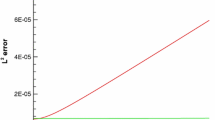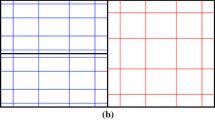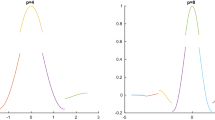Abstract
High order entropy stable discontinuous Galerkin (DG) methods for nonlinear conservation laws satisfy an inherent discrete entropy inequality. The construction of such schemes has relied on the use of carefully chosen nodal points (Gassner in SIAM J Sci Comput 35(3):A1233–A1253, 2013; Fisher and Carpenter in J Comput Phys 252:518–557, 2013; Carpenter et al. in SIAM J Sci Comput 36(5):B835–B867, 2014; Crean et al. in J Comput Phys 356:410–438, 2018; Chan et al. in Efficient entropy stable Gauss collocation methods, 2018. arXiv:1809.01178) or volume and surface quadrature rules (Chan in J Comput Phys 362:346–374, 2018; Chan and Wilcox in J Comput Phys 378:366–393, 2019) to produce operators which satisfy a summation-by-parts (SBP) property. In this work, we show how to construct “modal” DG formulations which are entropy stable for volume and surface quadratures under which the SBP property in Chan (2018) does not hold. These formulations rely on an alternative skew-symmetric construction of operators which automatically satisfy the SBP property. Entropy stability then follows for choices of volume and surface quadrature which satisfy sufficient accuracy conditions. The accuracy of these new SBP operators depends on a separate set of conditions on quadrature accuracy, with design order accuracy recovered under the usual assumptions of degree \(2N-1\) volume quadratures and degree 2N surface quadratures. We conclude with numerical experiments verifying the accuracy and stability of the proposed formulations, and discuss an application of these formulations for entropy stable DG schemes on mixed quadrilateral-triangle meshes.



Similar content being viewed by others
Notes
It is possible to construct the geometric terms for \(N_{\mathrm{geo}} = N\) using a local \(H_\mathrm{div}\) basis where
$$\begin{aligned} \varvec{r}^i \in Q^{N-1,N,N} \times Q^{N,N-1,N} \times Q^{N,N,N-1}. \end{aligned}$$Then, the geometric terms satisfy \(\nabla \times \varvec{r}^i \in Q^{N,N-1,N-1}\times Q^{N-1,N,N-1} \times Q^{N-1,N-1,N}\) with traces in \(Q^{N-1}\), and Assumption 1 holds under degree \((2N-1)\) volume and surface quadrature. This approach will be investigated in more detail in future work.
References
Wang, Z.J., Fidkowski, K., Abgrall, R., Bassi, F., Caraeni, D., Cary, A., Deconinck, H., Hartmann, R., Hillewaert, K., Huynh, H.T., et al.: High-order CFD methods: current status and perspective. Int. J. Numer. Methods Fluids 72(8), 811–845 (2013)
Ainsworth, M.: Dispersive and dissipative behaviour of high order discontinuous Galerkin finite element methods. J. Comput. Phys. 198(1), 106–130 (2004)
Visbal, M.R., Gaitonde, D.V.: High-order-accurate methods for complex unsteady subsonic flows. AIAA J. 37(10), 1231–1239 (1999)
Tadmor, E.: The numerical viscosity of entropy stable schemes for systems of conservation laws. I. Math. Comput. 49(179), 91–103 (1987)
Tadmor, E.: Entropy stability theory for difference approximations of nonlinear conservation laws and related time-dependent problems. Acta Numer. 12, 451–512 (2003)
Fjordholm, U.S., Mishra, S., Tadmor, E.: Arbitrarily high-order accurate entropy stable essentially nonoscillatory schemes for systems of conservation laws. SIAM J. Numer. Anal. 50(2), 544–573 (2012)
Chandrashekar, P.: Kinetic energy preserving and entropy stable finite volume schemes for compressible Euler and Navier–Stokes equations. Commun. Comput. Phys. 14(5), 1252–1286 (2013)
Tadmor, E.: Entropy stable schemes. Handbook Numer. Anal. 17, 467–493 (2016)
Ray, D., Chandrashekar, P., Fjordholm, U.S., Mishra, S.: Entropy stable scheme on two-dimensional unstructured grids for Euler equations. Commun. Comput. Phys. 19(5), 1111–1140 (2016)
Fisher, T.C., Carpenter, M.H.: High-order entropy stable finite difference schemes for nonlinear conservation laws: finite domains. J. Comput. Phys. 252, 518–557 (2013)
Carpenter, M.H., Fisher, T.C., Nielsen, E.J., Frankel, S.H.: Entropy stable spectral collocation schemes for the Navier–Stokes equations: discontinuous interfaces. SIAM J. Sci. Comput. 36(5), B835–B867 (2014)
Gassner, G.J., Winters, A.R., Kopriva, D.A.: Split form nodal discontinuous Galerkin schemes with summation-by-parts property for the compressible Euler equations. J. Comput. Phys. 327, 39–66 (2016)
Gassner, G.J., Winters, A.R., Hindenlang, F.J., Kopriva, D.A.: The BR1 scheme is stable for the compressible Navier-Stokes equations. J. Sci. Comput. 77, 1–47 (2017)
Crean, J., Hicken, J.E., Fernández, D.C.D.R., Zingg, D.W., Carpenter, M.H.: Entropy-stable summation-by-parts discretization of the Euler equations on general curved elements. J. Comput. Phys. 356, 410–438 (2018)
Chan, J.: On discretely entropy conservative and entropy stable discontinuous Galerkin methods. J. Comput. Phys. 362, 346–374 (2018)
Chan, J., Wilcox, L.C.: On discretely entropy stable weight-adjusted discontinuous Galerkin methods: curvilinear meshes. J. Comput. Phys. 378, 366–393 (2019)
Crean, J., Hicken, J.E., Fernández, D.C.D.R., Zingg, D.W., Carpenter, M.H: High-order, entropy-stable discretizations of the Euler equations for complex geometries. In: 23rd AIAA Computational Fluid Dynamics Conference. American Institute of Aeronautics and Astronautics (2017)
Chen, T., Shu, C.-W.: Entropy stable high order discontinuous Galerkin methods with suitable quadrature rules for hyperbolic conservation laws. J. Comput. Phys. 345, 427–461 (2017)
Parsani, M., Carpenter, M.H., Fisher, T.C., Nielsen, E.J.: Entropy stable staggered grid discontinuous spectral collocation methods of any order for the compressible Navier–Stokes equations. SIAM J. Sci. Comput. 38(5), A3129–A3162 (2016)
Del Rey Fernández, D.C., Crean, J., Carpenter, M.H., Hicken, J.E.: Staggered-grid entropy-stable multidimensional summation-by-parts discretizations on curvilinear coordinates. J. Comput. Phys. 392, 161–186 (2019)
Chan, J., Fernandez, D.C., Carpenter, M.H.: Efficient entropy stable Gauss collocation methods. arXiv preprint arXiv:1809.01178. (2018)
Friedrich, L., Winters, A.R., Fernández, D.C., Gassner, G.J., Parsani, M., Carpenter, M.H.: An Entropy Stable h/p Non-conforming Discontinuous Galerkin Method with the Summation-by-Parts Property. arXiv preprint arXiv:1712.10234. (2017)
Hicken, J.E., Del Rey Fernández, D.C., Zingg, D.W.: Multidimensional summation-by-parts operators: General theory and application to simplex elements. SIAM J. Sci. Comput. 38(4), A1935–A1958 (2016)
Hughes, T.J.R., Franca, L.P., Mallet, M.: A new finite element formulation for computational fluid dynamics: I. Symmetric forms of the compressible Euler and Navier-Stokes equations and the second law of thermodynamics. Comput. Methods Appl. Mech. Eng. 54(2), 223–234 (1986)
Mock, M.S.: Systems of conservation laws of mixed type. J. Differ. Equ. 37(1), 70–88 (1980)
Harten, A.: On the symmetric form of systems of conservation laws with entropy. J. Comput. Phys. 49(1), 151–164 (1983)
Dafermos, C.M.: Hyperbolic Conservation Laws in Continuum Physics. Springer, Berlin (2005)
Chan, J., Wang, Z., Modave, A., Remacle, J.-F., Warburton, T.: GPU-accelerated discontinuous Galerkin methods on hybrid meshes. J. Comput. Phys. 318, 142–168 (2016)
Gassner, G.J.: A skew-symmetric discontinuous Galerkin spectral element discretization and its relation to SBP-SAT finite difference methods. SIAM J. Sci. Comput. 35(3), A1233–A1253 (2013)
Del Rey Fernández, D.C., Boom, P.D., Zingg, D.W.: A generalized framework for nodal first derivative summation-by-parts operators. J. Comput. Phys. 266, 214–239 (2014)
Ranocha, H.: Generalised summation-by-parts operators and variable coefficients. J. Comput. Phys. 362, 20–48 (2018)
Chen, T., Shu, C.-W.: Review of entropy stable discontinuous Galerkin methods for systems of conservation laws on unstructured simplex meshes. https://www.brown.edu/research/projects/scientificcomputing/sites/brown.edu.research.projects.scientific-computing/files/uploads/Review%20of%20entropy%20stable%20discontinuous%20Galerkin%20methods.pdf
Xiao, H., Gimbutas, Z.: A numerical algorithm for the construction of efficient quadrature rules in two and higher dimensions. Comput. Math. Appl. 59, 663–676 (2010)
Shi, C., Shu, C.-W.: On local conservation of numerical methods for conservation laws. Computers and Fluids (2017)
Canuto, C., Hussaini, M.Y., Quarteroni, A., Zang, T.A.: Spectral Methods: Fundamentals in Single Domains. Springer, Berlin (2007)
Kopriva, D.A., Gassner, G.J.: Geometry effects in nodal discontinuous Galerkin methods on curved elements that are provably stable. Appl. Math. Comput. 272, 274–290 (2016)
Kopriva, D.A., Hindenlang, F.J., Bolemann, T., Gassner, G.J.: Free-Stream Preservation for Curved Geometrically Non-conforming Discontinuous Galerkin Spectral Elements. J. Sci. Comput. 79(3), 1389–1408 (2019)
Kopriva, D.A.: Metric identities and the discontinuous spectral element method on curvilinear meshes. J. Sci. Comput. 26(3), 301–327 (2006)
Thomas, P.D., Lombard, C.K.: Geometric conservation law and its application to flow computations on moving grids. AIAA J. 17(10), 1030–1037 (1979)
Visbal, M.R., Gaitonde, D.V.: On the use of higher-order finite-difference schemes on curvilinear and deforming meshes. J. Comput. Phys. 181(1), 155–185 (2002)
Hindenlang, F., Gassner, G.J., Altmann, C., Beck, A., Staudenmaier, M., Munz, C.-D.: Explicit discontinuous Galerkin methods for unsteady problems. Comput. Fluids 61, 86–93 (2012)
Hesthaven, J.S.: From electrostatics to almost optimal nodal sets for polynomial interpolation in a simplex. SIAM J. Numer. Anal. 35(2), 655–676 (1998)
Warburton, T.: An explicit construction of interpolation nodes on the simplex. J. Eng. Math. 56(3), 247–262 (2006)
Chan, J., Warburton, T.: A comparison of high order interpolation nodes for the pyramid. SIAM J. Sci. Comput. 37(5), A2151–A2170 (2015)
Winters, A.R., Derigs, D., Gassner, G.J., Walch, S.: A uniquely defined entropy stable matrix dissipation operator for high Mach number ideal MHD and compressible Euler simulations. J. Comput. Phys. 332, 274–289 (2017)
Ismail, F., Roe, P.L.: Affordable, entropy-consistent Euler flux functions II: entropy production at shocks. J. Comput. Phys. 228(15), 5410–5436 (2009)
Ranocha, H.: Comparison of some entropy conservative numerical fluxes for the Euler equations. J. Sci. Comput. 76(1), 216–242 (2018)
Shu, C.-W.: Essentially non-oscillatory and weighted essentially non-oscillatory schemes for hyperbolic conservation laws. In: Advanced Numerical Approximation of Nonlinear Hyperbolic Equations, pp. 325–432. Springer, Berlin (1998)
Carpenter, M.H., Kennedy, C.A.: Fourth-order \(2n\)-storage Runge–Kutta schemes. Technical Report NASA-TM-109112, NAS 1.15:109112, NASA Langley Research Center (1994)
Chan, J., Evans, J.A.: Multi-patch discontinuous Galerkin isogeometric analysis for wave propagation: Explicit time-stepping and efficient mass matrix inversion. Comput. Methods Appl. Mech. Eng. 333, 22–54 (2018)
Hindenlang, F.J., Gassner, G.J.: On the order reduction of entropy stable DGSEM for the compressible Euler equations. arXiv preprint arXiv:1901.05812 (2019)
Gassner, G., Kopriva, D.A.: A comparison of the dispersion and dissipation errors of Gauss and Gauss–Lobatto discontinuous Galerkin spectral element methods. SIAM J. Sci. Comput. 33(5), 2560–2579 (2011)
Quarteroni, A., Valli, A.: Numerical Approximation of Partial Differential Equations. Springer, Berlin (1994)
Krivodonova, L., Qin, R.: An analysis of the spectrum of the discontinuous Galerkin method. Appl. Numer. Math. 64, 1–18 (2013)
Acknowledgements
The author thanks David C. Del Rey Fernandez for helpful discussions, as well as the two anonymous reviewers whose comments significantly improved the readabilty of this manuscript. Jesse Chan is supported by the National Science Foundation under awards DMS-1719818 and DMS-1712639.
Author information
Authors and Affiliations
Corresponding author
Additional information
Publisher's Note
Springer Nature remains neutral with regard to jurisdictional claims in published maps and institutional affiliations.
A Dependence of Inverse and Trace Constants on Quadrature
A Dependence of Inverse and Trace Constants on Quadrature
The maximum stable timestep under explicit time-stepping depends on specific choices of volume and surface quadrature. The dependence of timestep on quadrature has been documented for tensor product elements in [52], where they showed that for a high order Taylor method in time, the maximum stable timestep under \((N+1)\)-point GLL volume and surface quadratures is roughly twice as large as the maximum stable timestep when volume/surface integrals are approximated using \((N+1)\) point Gauss quadratures.
This discrepancy can be understood in terms of constants in finite element inverse and trace inequalities. It was shown in [28, 50] that, for linear problems, the maximum stable time-step scales inversely with the order-dependent constants \(C_I, C_T\), where
Here, the integrals over \({\widehat{D}}, \partial {\widehat{D}}\) are computed using the same volume and surface quadrature rules used for computations. These constants can be used to bound surface integrals which appear in DG formulations, which can in turn be used to construct bounds on the spectral radius of DG discretization matrices. The maximum stable timestep \(dt_{\max }\) is thus inversely proportional to the inverse and trace constants
The constants \(C_I, C_T\) depend on the choices of volume and surface quadrature used to evaluate each of the integrals in (31). It is known that \(L^2\) norm computed using GLL quadrature is weaker than the full \(L^2\) norm [35, 53]. For the domain \({\widehat{D}} = [-1,1]^d\) in d dimensions, it can be shown that
where the middle integral is under-integrated using GLL quadrature. In other words, the discrete \(L^2\) norm induced using GLL quadrature is weaker than the \(L^2\) norm induced by a more accurate quadrature rule, which will be reflected in the trace and inverse constants.
Table 2 shows trace and inverse constants for triangular and quadrilateral elements under several different configurations of quadrature. For quadrilateral elements at high orders, we observe that the degree N inverse constants \(C_I\) under Gauss quadrature are roughly as large as the degree \((N+1)\) inverse constants under (volume) GLL quadrature. The degree N trace constants \(C_T\) under Gauss quadrature are exactly equal to the degree \((N+1)\) trace constants under GLL quadrature, which was proven in [28]. Trace constants under GLL volume and Gauss surface quadrature are also identical to trace constants computed using GLL quadrature for both volume and surface integrals, which is a consequence of the lower bound in (32).
Several observations can be made based on the values of \(C_I, C_T\) presented in Table 2. On quadrilaterals, the maximum stable time-step for a degree N DG scheme using Gauss quadrature is expected to be smaller than that of a degree N scheme using GLL quadrature, which matches observations in [52]. Additionally, the maximum stable timestep under GLL volume quadrature and Gauss surface quadrature should be the same as the maximum stable timestep when GLL quadrature is used for both volume and surface integrals (e.g. DG-SEM). For triangles, the maximum stable timestep should be smaller under surface GLL quadrature compared to surface Gauss quadrature. However, we note that, while bounds on the maximum stable time-step can be derived based on the constants \(C_I, C_T\) [28, 50], these bounds are not tight for upwind or dissipative fluxes [54].
Rights and permissions
About this article
Cite this article
Chan, J. Skew-Symmetric Entropy Stable Modal Discontinuous Galerkin Formulations. J Sci Comput 81, 459–485 (2019). https://doi.org/10.1007/s10915-019-01026-w
Received:
Revised:
Accepted:
Published:
Issue Date:
DOI: https://doi.org/10.1007/s10915-019-01026-w




